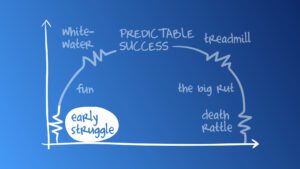You did it! You took the leap and started the business. There is a wonderful but often all-too-short honeymoon stage you quickly come face-to-face with the personal understanding of why over 80% of businesses never get through Early Struggle. It is hard, really hard.
Welcome to Early Struggle
Despite our best efforts to romanticize the process of starting a new business, here’s the truth. The start of any business is an existential fight for survival. It’s like a ship setting off for its maiden voyage in the middle of a hurricane.
Almost everything you do, you’re doing for the first time. The learning curve is steep, but you have push through and fast. You have to get through the breakers and steer clear of the rocks and underwater reefs, all while the environment itself is trying to take your ship down and bring your adventure to an early and tragic end.
In many ways, it is the most difficult part of the entire lifecycle. More businesses die in Early Struggle than every other stage combined. While there are many reasons why businesses fail.
There is only one reason that is responsible for every lost business in Early Struggle: The business was unable to find a profitable, sustainable market before it ran out of cash.
[bctt tweet=”There is only one reason that is responsible for every lost business in Early Struggle: The business was unable to find a profitable, sustainable market before it ran out of cash.” username=”8figurefocus”]
This is true for nonprofits as well. It’s even true for intrapreneurial startups and new product lines within existing companies. Every one of them failed to find their profitable, sustainable market and then ran out of cash and closed their doors.
Getting out of Early Struggle
If Early Struggle is marked by the race to find a profitable, sustainable market before you run out of cash, then the path to getting out is relatively simple to understand. You need to focus all of your resources, all of your energy, and all of your time on finding a market for your minimally viable product or service. There are three key elements here.
1. A Profitable Market: This one is pretty straight-forward. You need your top-line revenue to translate into bottom-line profit. This plays out a little differently in big money tech ventures, but for the vast majority of you, you need to get profitable on every sale as soon as possible.
2. A Sustainable Market: Sustainability is almost exclusively about your acquisition costs (and variable costs). How much does it cost to find new customers and sell them your product or service? To put it simply, to get out of Early Struggle, you need to find a repeatable way of selling to people or businesses that don’t already know or trust you. A Profitable, Sustainable Market: It’s relatively easy to achieve profit without sustainability, and it’s relatively simple to achieve sustainable revenue without profit. However, to get out of Early Struggle, you have to have both.
3. Cash: It’s going to cost at least three times as much as you think to start your business. And it’s probably going to take 3-5 years to get into regular profitability and out of Early Struggle. Put all this together, and you come to one conclusion. Cash is king. You need to save up as much as you can and preserve it as long as you can to give yourself a fighting chance at finding your profitable, sustainable market. To keep this article from becoming incredibly long, I’m going to reference several other articles I’ve written so you can dig in and get more information where you need it most.
- Stockpile cash, ruthlessly pursue profitability and don’t stop until it’s sustainable Read more on how to get out of early struggle
- Don’t overdevelop your product or service at the expense of your ability to market and effectively sell your product or service. Why so many businesses fail at this
- Find one or more operators who love executing on your vision and getting stuff done How to hire the people you need
- Build your sales and marketing muscle Learn more about marketing (I have a whole category on this one point)
Though it is still challenging to do, you’ll have much more confidence knowing that you’ve got your eye on the prize and your focus right where it needs to be. You will know you are out of Early Struggle when you can get into the black for a week and then remain there, sustaining profitability for a full quarter.
If you’re in Early Struggle, you may want to consider the online course How to Get Out of Early Struggle and into Fun. If you enroll today, you’ll get immediate access to the Predictable Success Playbook to help you get through this incredibly difficult stage and into Fun!
Getting stuck in Early Struggle
Early Struggle isn’t a place most people want to stay in for long. You will want to get out as quickly as you can. Under normal circumstances, this can take 3-5 years.
If you really focus on the steps in the section above, with a little luck, you can shorten that time frame dramatically. If you don’t focus, you can, in theory, stay in Early Struggle for a long time. It’s a pretty brutal existence.
If it’s so awful, how do some business owners get stuck here?
The truth is several traps that can keep you and your business in Early Struggle far longer than you’d like. For a full description of each of the traps, see this article: 6 traps that cause new businesses to fail.
- The artisan trap: In the artisan trap, the main sales rep and service provider are the same person, leaving the business able to do only one thing at a time, sell or provide the service. Unable to do both, the business will float in and out of profitability almost indefinitely.
- The family affair: Your friends and family and colleagues probably do not represent a sustainable market. You need to build a sales and marketing system that allows you to sell to people who don’t already know you consistently.
- The false finish line: Some businesses want to get out of Early Struggle so bad that at the first sign of profitability, they stop, put a victory flag in the ground. Then they start doing more of the things they want to do and start neglecting all the things they need to do. Coming up short of sustainability, they inevitably find themselves back in Early Struggle frustrated and unsure of themselves.
- The Early Struggle addiction: There is a small group we call them Early Struggle Obsessives. In a way, they need the adrenaline that comes from having your back up against the wall to get clear and stay excited. These types often unknowingly self-sabotage their growing business keeping it from ever making it to Fun.
- The Wal-Mart® Dilemma: You cannot truly get out of Early Struggle if one client represents most of your revenue. Things will go well for a while, but you’re “cheating” the stage, and it will catch up with you.
- The Loss-Leader Startup: Some founders and entrepreneurs I’ve counseled have wanted to intentionally price their product so low that they take a loss on every unit. They use fancy language like “loss leader” and point to Uber and Tesla, but they’re wrong. To make the loss-leader approach work, you need to have about $1B. You probably don’t have $1B, so all the loss-leader approach will do is help you to sell an unprofitable product or service until you run out of cash. You need from day one to ruthlessly pursue profitability.
Closing
Again, if you’re in Early Struggle, you may want to consider the online course How to Get Out of Early Struggle and in to Fun. If you enroll today, you’ll get immediate access to the Predictable Success playbook that will help you get through this incredibly difficult stage and into Fun!
If you think you are in Early Struggle but aren’t quite sure, I’d like to encourage you to take the free Lifecycle assessment at https://bit.ly/Lifecycle-Quiz to find out for sure and to see around the corner at what is next for your business!
[yotuwp type=”playlist” id=”PLNTSkWehajGNHpbps4vk4gjXa1mvGe_xX” ]


 6 Traps That Cause New Businesses to Fail
6 Traps That Cause New Businesses to Fail